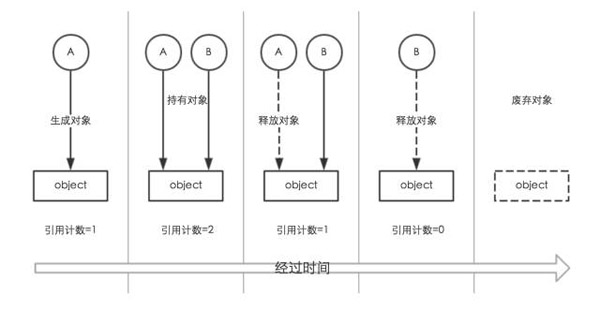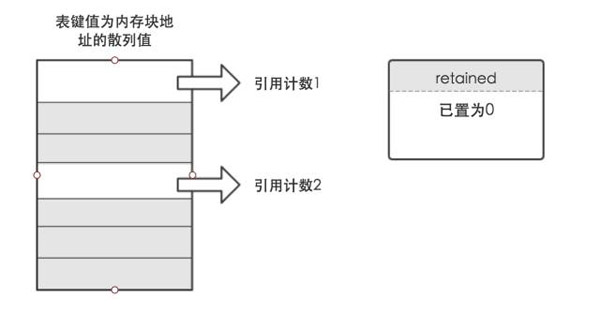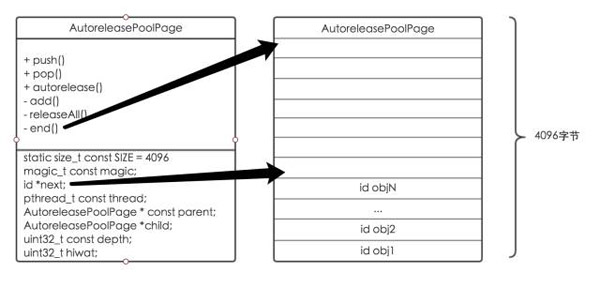1 似乎每个人在学习 iOS 过程中都考虑过的问题
- alloc retain release delloc 做了什么?
- autoreleasepool 是怎样实现的?
- __unsafe_unretained 是什么?
- Block 是怎样实现的
- 什么时候会引起循环引用,什么时候不会引起循环引用?
所以我将在本篇博文中详细的从 ARC 解释到 iOS 的内存管理,以及 Block 相关的原理、源码。
2 从 ARC 说起
说 iOS 的内存管理,就不得不从 ARC(Automatic Reference Counting / 自动引用计数) 说起, ARC 是 WWDC2011 和 iOS5 引入的变化。ARC 是 LLVM 3.0 编译器的特性,用来自动管理内存。
与 Java 中 GC 不同,ARC 是编译器特性,而不是基于运行时的,所以 ARC 其实是在编译阶段自动帮开发者插入了管理内存的代码,而不是实时监控与回收内存。
ARC 的内存管理规则可以简述为:
- 每个对象都有一个『被引用计数』
- 对象被持有,『被引用计数』+1
- 对象被放弃持有,『被引用计数』-1
- 『引用计数』=0,释放对象
3 你需要知道
- 包含 NSObject 类的 Foundation 框架并没有公开
- Core Foundation 框架源代码,以及通过 NSObject 进行内存管理的部分源代码是公开的。
- GNUstep 是 Foundation 框架的互换框架
GNUstep 也是 GNU 计划之一。将 Cocoa Objective-C 软件库以自由软件方式重新实现
某种意义上,GNUstep 和 Foundation 框架的实现是相似的
通过 GNUstep 的源码来分析 Foundation 的内存管理
4 alloc retain release dealloc 的实现
4.1 GNU – alloc
查看 GNUStep 中的 alloc 函数。
GNUstep/modules/core/base/Source/NSObject.m alloc:
- + (id) alloc
- {
- return [self allocWithZone: NSDefaultMallocZone()];
- }
- + (id) allocWithZone: (NSZone*)z
- {
- return NSAllocateObject (self, 0, z);
- }
GNUstep/modules/core/base/Source/NSObject.m NSAllocateObject:
- struct obj_layout {
- NSUInteger retained;
- };
- NSAllocateObject(Class aClass, NSUInteger extraBytes, NSZone *zone)
- {
- int size = 计算容纳对象所需内存大小;
- id new = NSZoneCalloc(zone, 1, size);
- memset (new, 0, size);
- new = (id)&((obj)new)[1];
- }
NSAllocateObject 函数通过调用 NSZoneCalloc 函数来分配存放对象所需的空间,之后将该内存空间置为 nil,***返回作为对象而使用的指针。
我们将上面的代码做简化整理:
GNUstep/modules/core/base/Source/NSObject.m alloc 简化版本:
- struct obj_layout {
- NSUInteger retained;
- };
- + (id) alloc
- {
- int size = sizeof(struct obj_layout) + 对象大小;
- struct obj_layout *p = (struct obj_layout *)calloc(1, size);
- return (id)(p+1)
- return [self allocWithZone: NSDefaultMallocZone()];
- }
alloc 类方法用 struct obj_layout 中的 retained 整数来保存引用计数,并将其写入对象的内存头部,该对象内存块全部置为 0 后返回。
一个对象的表示便如下图:
4.2 GNU – retain
GNUstep/modules/core/base/Source/NSObject.m retainCount:
- - (NSUInteger) retainCount
- {
- return NSExtraRefCount(self) + 1;
- }
- inline NSUInteger
- NSExtraRefCount(id anObject)
- {
- return ((obj_layout)anObject)[-1].retained;
- }
GNUstep/modules/core/base/Source/NSObject.m retain:
- - (id) retain
- {
- NSIncrementExtraRefCount(self);
- return self;
- }
- inline void
- NSIncrementExtraRefCount(id anObject)
- {
- if (((obj)anObject)[-1].retained == UINT_MAX - 1)
- [NSException raise: NSInternalInconsistencyException
- format: @"NSIncrementExtraRefCount() asked to increment too far”];
- ((obj_layout)anObject)[-1].retained++;
- }
以上代码中, NSIncrementExtraRefCount 方法首先写入了当 retained 变量超出***值时发生异常的代码(因为 retained 是 NSUInteger 变量),然后进行 retain ++ 代码。
4.3 GNU – release
和 retain 相应的,release 方法做的就是 retain --。
GNUstep/modules/core/base/Source/NSObject.m release
- - (oneway void) release
- {
- if (NSDecrementExtraRefCountWasZero(self))
- {
- [self dealloc];
- }
- }
- BOOL
- NSDecrementExtraRefCountWasZero(id anObject)
- {
- if (((obj)anObject)[-1].retained == 0)
- {
- return YES;
- }
- ((obj)anObject)[-1].retained--;
- return NO;
- }
4.4 GNU – dealloc
dealloc 将会对对象进行释放。
GNUstep/modules/core/base/Source/NSObject.m dealloc:
- - (void) dealloc
- {
- NSDeallocateObject (self);
- }
- inline void
- NSDeallocateObject(id anObject)
- {
- obj_layout o = &((obj_layout)anObject)[-1];
- free(o);
- }
4.***pple 实现
在 Xcode 中 设置 Debug -> Debug Workflow -> Always Show Disassenbly 打开。这样在打断点后,可以看到更详细的方法调用。
通过在 NSObject 类的 alloc 等方法上设置断点追踪可以看到几个方法内部分别调用了:
retainCount
- __CFdoExternRefOperation
- CFBasicHashGetCountOfKey
retain
- __CFdoExternRefOperation
- CFBasicHashAddValue
release
- __CFdoExternRefOperation
- CFBasicHashRemoveValue
可以看到他们都调用了一个共同的 __CFdoExternRefOperation 方法。
该方法从前缀可以看到是包含在 Core Foundation,在 CFRuntime.c 中可以找到,做简化后列出源码:
CFRuntime.c __CFDoExternRefOperation:
- int __CFDoExternRefOperation(uintptr_t op, id obj) {
- CFBasicHashRef table = 取得对象的散列表(obj);
- int count;
- switch (op) {
- case OPERATION_retainCount:
- count = CFBasicHashGetCountOfKey(table, obj);
- return count;
- break;
- case OPERATION_retain:
- count = CFBasicHashAddValue(table, obj);
- return obj;
- case OPERATION_release:
- count = CFBasicHashRemoveValue(table, obj);
- return 0 == count;
- }
- }
所以 __CFDoExternRefOperation 是针对不同的操作,进行具体的方法调用,如果 op 是 OPERATION_retain,就去掉用具体实现 retain 的方法。
从 BasicHash 这样的方法名可以看出,其实引用计数表就是散列表。
key 为 hash(对象的地址) value 为 引用计数。
下图是 Apple 和 GNU 的实现对比:
5 autorelease 和 autorelaesepool
在苹果对于 NSAutoreleasePool 的文档中表示:
每个线程(包括主线程),都维护了一个管理 NSAutoreleasePool 的栈。当创先新的 Pool 时,他们会被添加到栈顶。当 Pool 被销毁时,他们会被从栈中移除。
autorelease 的对象会被添加到当前线程的栈顶的 Pool 中。当 Pool 被销毁,其中的对象也会被释放。
当线程结束时,所有的 Pool 被销毁释放。
对 NSAutoreleasePool 类方法和 autorelease 方法打断点,查看其运行过程,可以看到调用了以下函数:
- NSAutoreleasePool *pool = [[NSAutoreleasePool alloc] init];
- // 等同于 objc_autoreleasePoolPush
- id obj = [[NSObject alloc] init];
- [obj autorelease];
- // 等同于 objc_autorelease(obj)
- [NSAutoreleasePool showPools];
- // 查看 NSAutoreleasePool 状况
- [pool drain];
- // 等同于 objc_autoreleasePoolPop(pool)
[NSAutoreleasePool showPools] 可以看到当前线程所有 pool 的情况:
- objc[21536]: ##############
- objc[21536]: AUTORELEASE POOLS for thread 0x10011e3c0
- objc[21536]: 2 releases pending.
- objc[21536]: [0x101802000] ................ PAGE (hot) (cold)
- objc[21536]: [0x101802038] ################ POOL 0x101802038
- objc[21536]: [0x101802040] 0x1003062e0 NSObject
- objc[21536]: ##############
- Program ended with exit code: 0
在 objc4 中可以查看到 AutoreleasePoolPage:
- objc4/NSObject.mm AutoreleasePoolPage
- class AutoreleasePoolPage
- {
- static inline void *push()
- {
- 生成或者持有 NSAutoreleasePool 类对象
- }
- static inline void pop(void *token)
- {
- 废弃 NSAutoreleasePool 类对象
- releaseAll();
- }
- static inline id autorelease(id obj)
- {
- 相当于 NSAutoreleasePool 类的 addObject 类方法
- AutoreleasePoolPage *page = 取得正在使用的 AutoreleasePoolPage 实例;
- }
- id *add(id obj)
- {
- 将对象追加到内部数组
- }
- void releaseAll()
- {
- 调用内部数组中对象的 release 方法
- }
- };
- void *
- objc_autoreleasePoolPush(void)
- {
- if (UseGC) return nil;
- return AutoreleasePoolPage::push();
- }
- void
- objc_autoreleasePoolPop(void *ctxt)
- {
- if (UseGC) return;
- AutoreleasePoolPage::pop(ctxt);
- }
AutoreleasePoolPage 以双向链表的形式组合而成(分别对应结构中的 parent 指针和 child 指针)。
thread 指针指向当前线程。
每个 AutoreleasePoolPage 对象会开辟4096字节内存(也就是虚拟内存一页的大小),除了上面的实例变量所占空间,剩下的空间全部用来储存autorelease对象的地址。
next 指针指向下一个 add 进来的 autorelease 的对象即将存放的位置。
一个 Page 的空间被占满时,会新建一个 AutoreleasePoolPage 对象,连接链表。
6 __unsafe_unretained
有时候我们除了 __weak 和 __strong 之外也会用到 __unsafe_unretained 这个修饰符,那么我们对 __unsafe_unretained 了解多少?
__unsafe_unretained 是不安全的所有权修饰符,尽管 ARC 的内存管理是编译器的工作,但附有 __unsafe_unretained 修饰符的变量不属于编译器的内存管理对象。赋值时即不获得强引用也不获得弱引用。
来运行一段代码:
- id __unsafe_unretained obj1 = nil;
- {
- id __strong obj0 = [[NSObject alloc] init];
- obj1 = obj0;
- NSLog(@"A: %@", obj1);
- }
- NSLog(@"B: %@", obj1);
运行结果:
- 2017-01-12 19:24:47.245220 __unsafe_unretained[55726:4408416] A:
- 2017-01-12 19:24:47.246670 __unsafe_unretained[55726:4408416] B:
- Program ended with exit code: 0
对代码进行详细分析:
- id __unsafe_unretained obj1 = nil;
- {
- // 自己生成并持有对象
- id __strong obj0 = [[NSObject alloc] init];
- // 因为 obj0 变量为强引用,
- // 所以自己持有对象
- obj1 = obj0;
- // 虽然 obj0 变量赋值给 obj1
- // 但是 obj1 变量既不持有对象的强引用,也不持有对象的弱引用
- NSLog(@"A: %@", obj1);
- // 输出 obj1 变量所表示的对象
- }
- NSLog(@"B: %@", obj1);
- // 输出 obj1 变量所表示的对象
- // obj1 变量表示的对象已经被废弃
- // 所以此时获得的是悬垂指针
- // 错误访问
所以,***的 NSLog 只是碰巧正常运行,如果错误访问,会造成 crash
在使用 __unsafe_unretained 修饰符时,赋值给附有 __strong 修饰符变量时,要确保对象确实存在































